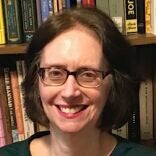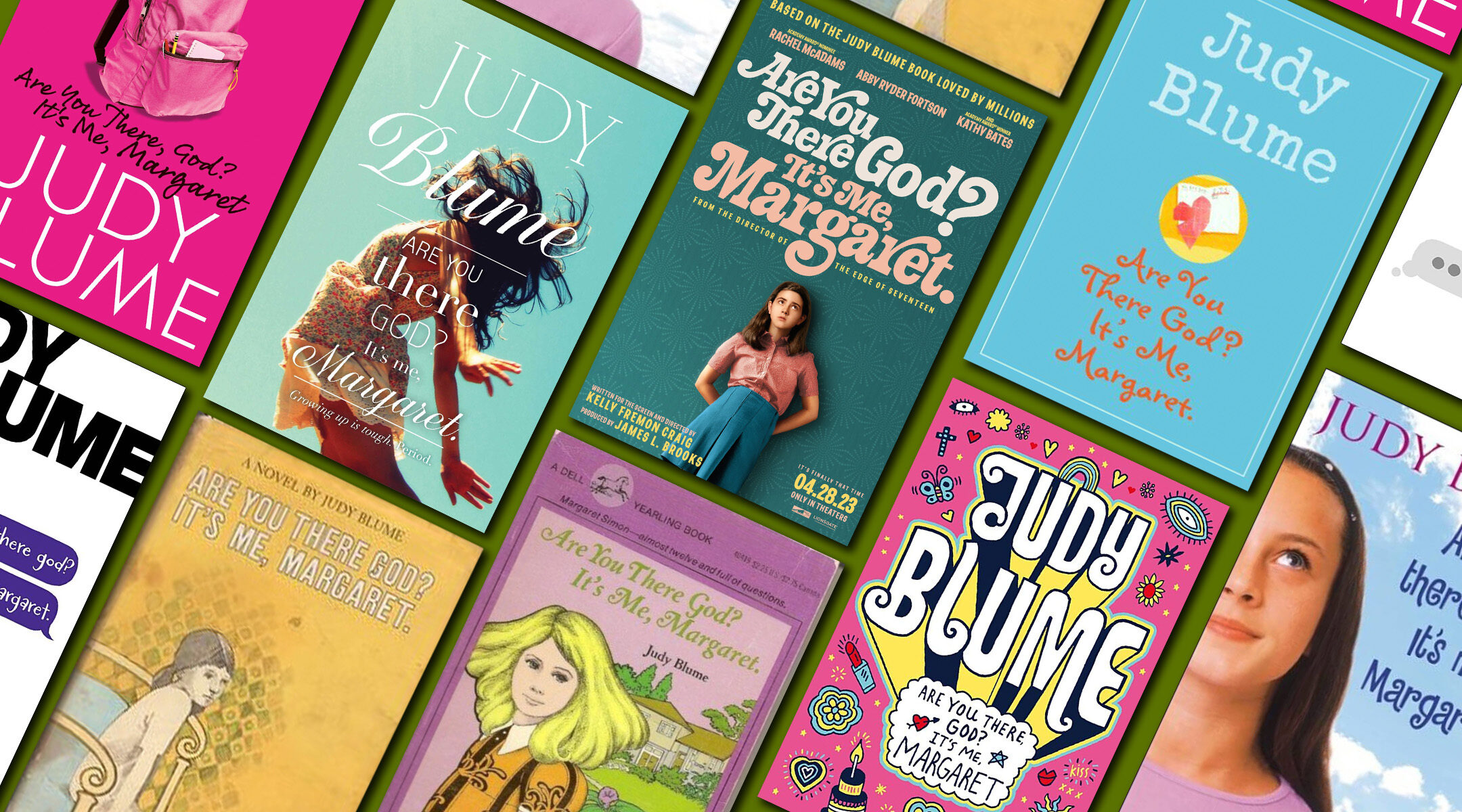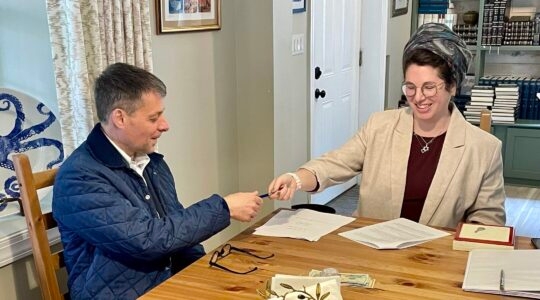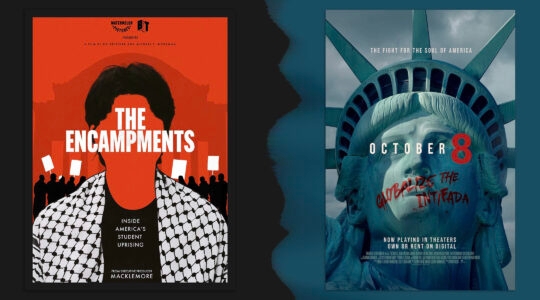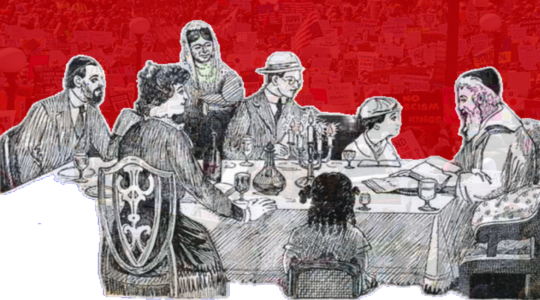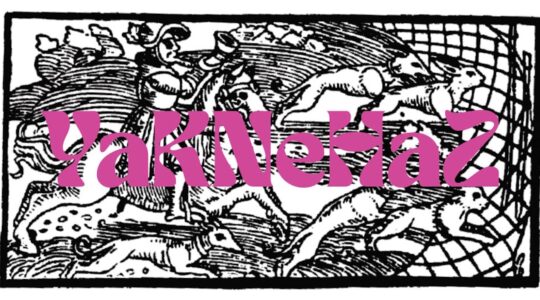(JTA) — When Judy Blume’s young adult novel “Are You There God? It’s Me, Margaret” appeared in 1970, intermarried families were a small segment of the American Jewish population. Perhaps 17% of Jews were married to someone who wasn’t Jewish; today, 42% of married Jews have a spouse who is not Jewish, and in the past decade, 61% of Jews married non-Jewish partners.
Through the 1960s, middle-grade and young adult fiction rarely acknowledged the existence of these families, reflecting and reinforcing their outsider status. Today it is routine for authors to address the reality of inter-religious and culturally mixed families, portraying them with insight and compassion. (See “Not Your All-American Girl” by Wendy Wan-Long Shang and Madelyn Rosenberg, “Becoming Brianna” by Terri Libenson and “The Whole Story of Half a Girl” by Veera Hiranandani.)
This change was made possible partly by Blume’s story of sixth-grader Margaret Simon and her one-sided conversations with God.
Blume’s status as a pioneer in young adult literature is usually associated with her honest approach to the emotional, physical and sexual milestones of growing up, with her works still attracting readers and still finding an honored place on lists of banned books. That legacy is being celebrated in April with a new documentary, Amazon Prime Video’s “Judy Blume Forever,” and a theatrical release by Lionsgate of a feature film version of “Are You There God?”
Yet her treatment of contested identity in intermarried families is as revolutionary as her openness about bras, menstruation and sexual feelings. Actors Lena Dunham and Molly Ringwald, comedian Samantha Bee and many authors, including Raina Telgemeier, Tayari Jones and Gary Shteyngart, have cited Blume’s influence on both their lives and their work. Book lists for intermarried families frequently list the novel as a resource.
Margaret Simon is 11 years old at the start of “Are You There God?” Her Jewish dad and Christian mom have pointedly ignored the possibility that their daughter might have questions about her identity. Along with other issues of teen angst, she feels compelled to decide if she is Jewish, Christian or neither. Without any guidance, the last alternative leaves her in a frightening void. As she pointedly asks God, in her ongoing series of questions for Him, “I can’t go on being nothing forever, can I?”
Margaret’s parents, Barbara Hutchins and Herb Simon, fell in love and defied their respective parents by marrying out of their faiths. They assure Margaret that she has no religion, but can choose one when she is older, oblivious to the fact that this solution seems more of a burden than a promise of future freedom. Their avoidance of any serious engagement with either religion or culture renders any possible choice unlikely.
Blume situates Margaret’s search within the specific landscape of post-World War II America. When the Simons decide to leave their Upper West Side home in New York City and move to suburban New Jersey, their decision suggests a coded reference to their religious status. Long Island is “too social,” an implied euphemism for “too Jewish.” Living there might have made it harder for their relatively unusual situation to be discreetly ignored. On the other hand, the more affluent Westchester and Connecticut are “too expensive” and “too inconvenient.” Farbrook, New Jersey, has enough Jews for it to feel right for Herb, but not so many as to make their mixed family stand out.
Margaret also suspects that her parents’ are determined to put distance between the Simons and Sylvia, her paternal grandmother, who lives in New York City. This gregarious woman shows up at their new home unannounced and toting deli foods, making it clear that Margaret’s one unambiguous connection to Judaism is not going to disappear. While Barbara’s parents utterly rejected her when she married a Jew, Sylvia has pragmatically decided to accept what she cannot change. In the postwar era, more Jews began to abandon or minimize religious practice, while still maintaining ethnically distinct customs. Like holiday observance or synagogue attendance, ethnic Jewish culture is also absent from the Simon home. Sylvia’s Jewish food, her frequent trips to Florida, even her combination of sarcasm and smothering warmth, provide Margaret with markers of the tradition her parents have eschewed.
Still, when Sylvia repeatedly asks Margaret if her (nonexistent) boyfriends are Jewish, the young girl is baffled. Given her own lack of consciousness of herself as Jewish, why would Margaret care?

Rachel McAdams and Abby Ryder Fortson in the forthcoming film adaptation of “Are You There God? It’s Me, Margaret.” (Dana Hawley/Lionsgate © 2022)
In the larger world of Farbrook, Margaret’s new friends seem to have more secure identities, conveniently defined by membership either in the “Y” (Young Men’s Christian Association) or the Jewish Community Center. Perfunctory attendance at Hebrew school until after one’s bar mitzvah is the furthest extent of her peers’ Jewishness. Margaret explains that her parents are “nothing” and that, prior to their marriage, they were Jewish and Christian, as if those identities could be cast off like an article of clothing. When Mr. Benedict, her enthusiastic young teacher, distributes a questionnaire, Margaret completes the prompt “I hate” with “religious holidays.” He attempts to draw her out about this troubling answer, and she scornfully observes that her teacher acted as if “he had uncovered some deep, dark mystery.”
On one level, he has. Her mother’s blandly universal definition of God as a “nice idea,” who “belongs to everybody,” is clearly a denial of the fractures in her family members’ lives.
Blume also captures the essence of mid-century non-Orthodox Judaism as comfortably accessible, yet also somewhat empty. On a visit to Grandma Sylvia’s elegant temple, the atmosphere is quietly decorous, the sanctuary filled with well-appointed congregants and beautifully arranged flowers. Sylvia’s rabbi greets Margaret with an enthusiastic “Good Yom Tov,” which he translates as “Happy New Year,” although it is actually a generic holiday greeting.
When Margaret later visits Presbyterian and Methodist churches, she notes the remarkable similarity among all three experiences.
The novel’s one incident of specific religious practice involves Margaret’s brief, unfinished confession in a classmate’s Catholic church. Having participated in bullying, Margaret tries to assuage her guilt through a ritual alien to both her father’s Judaism and her mother’s Protestant Christianity. She even momentarily confuses the priest with the silent God of her conversations. Nothing could be further from her parents’ rejection of religion, or from Grandma Sylvia’s loving assurance to Margaret that “I knew you were a Jewish girl at heart.”
When Margaret’s Christian grandparents decide to resume contact, the suppressed anger in the Simon home finally erupts. Herb is furious, and accuses his in-laws of only wanting to meet Margaret “to make sure she doesn’t have horns!” — a caustic reference to a persistent antisemitic myth. Blume had subtly foreshadowed this disruption of the status quo in a parallel event at school. When a Jewish student, backed by his parents, refuses to sing Christmas carols, the implicit agreement of the town’s Jews to quietly conform is broken. A Christian girl, in what seems an act of retaliation, then refuses to sing Hanukkah songs. These acts of resistance reinforce Margaret’s marginal status. Her intermarried family represents neither conformity with postwar norms nor an assertion of Jewish pride.
Blume appears to tip the scales in her portrayal of Mary and Paul Hutchins, Margaret’s maternal grandparents. Entirely unlikeable, simultaneously pushy and cold, they insist that the granddaughter they had never acknowledged is Christian. After their failed visit, Grandma Sylvia returns, along with her sweet and obviously Jewish new boyfriend, Mr. Binamin (“rhymes with cinnamon”). Readers rooting for the triumph of Margaret’s Jewish roots may breathe a sigh of relief here, but hope for a satisfying ending is illusory. Margaret’s search for a stable sense of self is still unfinished, and will not be satisfied by choosing membership in either the Y or the JCC.
For young readers, the novel’s discussion of religious identity proved as life-changing as its honest portrayal of puberty and menstruation. “I related to that kind of conflict of religion,” the comedian Chelsea Handler, who grew up in a mixed Jewish-Mormon home, told Blume in 2020. “At that time, I just found out my mom was Mormon, on top of thinking she was Jewish, and your books were such a reprieve for me and such a joy.”
More than 50 years ago, Judy Blume tackled a difficult subject, about both changing demographics and the search for authenticity in American Jewish life. Margaret’s conclusion that “twelve is very late to learn” about the essence of who you are still poses a challenge, while her persistent search for a meaningful identity offers a degree of optimism.
JTA has documented Jewish history in real-time for over a century. Keep our journalism strong by joining us in supporting independent, award-winning reporting.
